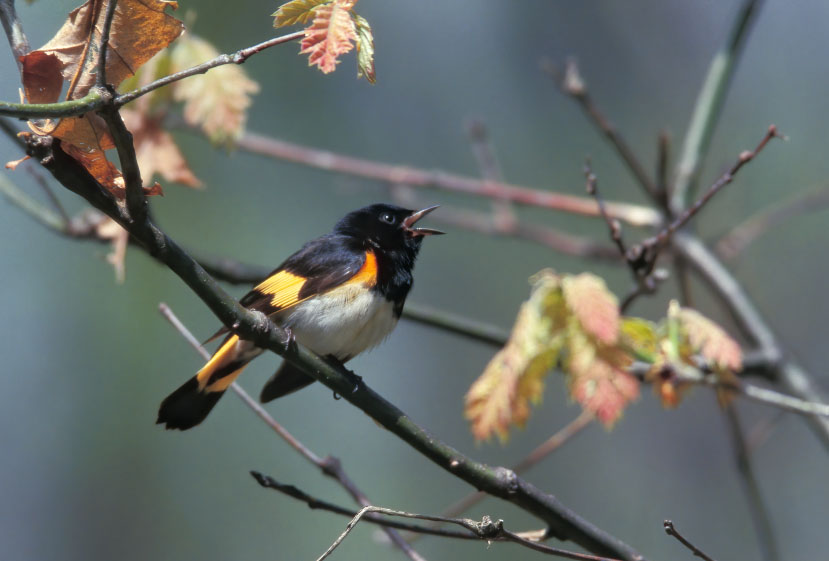The Story Behind Our App
by Lang Elliott, December 2021
You may be wondering why and how this project has come into being. In brief, it is endpoint of a long and arduous personal journey that was born of necessity, in the aftermath of violence. When I was about eight years old, I was in a firecracker accident where a “cherry bomb” exploded just above my head, greatly impairing my hearing in the high range.
So here’s the story: My neighbor Skip and I were tossing cherry bombs up into an oak tree, lighting the fuses and timing our throws in an attempt to blow up a squirrel’s nest (bad, bad, bad). Skip ended up tossing one that hit a limb and bounced straight back. “Watch out!,” he yelled. I turned my head, not knowing what his warning was about. Then “KA-BOOM!“, right on top my head (= instant karma?), and my life was forever changed, though I did not realize it at the time.
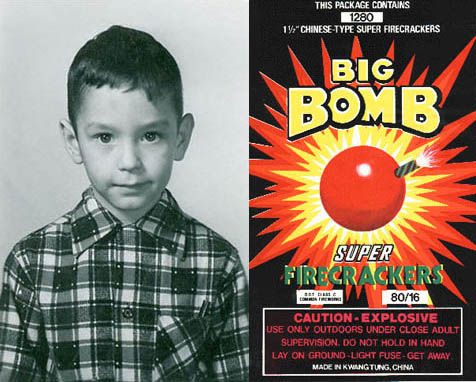
At first, I couldn’t hear anything, but after a few days my situation improved, at least enough so that I could hear other humans speaking again and basically get on with my life. Thereafter I noticed that I could no longer hear the “ping” of a dime falling to the sidewalk, or the steamy hiss of water boiling on the stove, but that didn’t seem like a big deal, so I forged ahead, thinking my hearing was “pretty much okay,” at least in terms of sensing what seemed (at the time anyway) to be the important things in life.
All went smoothly until many years later when I became a graduate student at the University of Maryland, studying animal behavior. That’s when a chance event brought my hearing loss back into focus.
I had made friends with Gene Morton, an accomplished ornithologist who specialized in bird vocalizations. During a late spring field excursion at Gene’s house along the Severn River, Gene got very excited when he heard a Worm-eating Warbler singing in the distance. I didn’t hear a thing, so Gene led me to the tree in which the bird was perched, and the two of us watched in awe as it sounded off from a limb no more than twenty feet away. Still, I didn’t hear a thing. I was devastated. Watching the warbler open and close its beak in silence was an excruciating experience. All of my imaginings of being a hear-all/see-all field biologist evaporated in that instant!
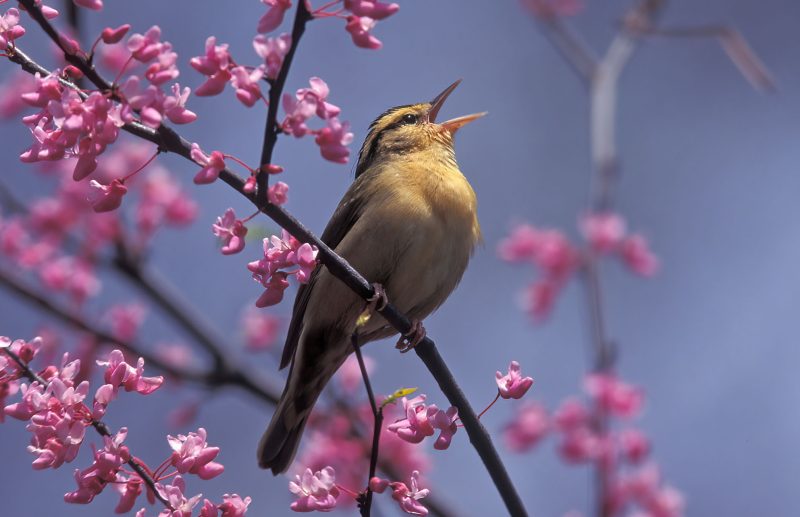
Although quite concerned about not being able to hear the warbler, I knew that its song was very high-pitched. Given that I had no trouble hearing robins and cardinals and blue jays, I was hopeful that I was still hearing “most” of what was happening in the bird world. Such a comforting thought, but just to be sure it was true, I decided to run a quick test.
It just so happened that I was the proud owner of a Uher reel-to-reel tape recorder that I had purchased several years before to record frogs and toads (an interest that had blossomed when I was an undergraduate). With spring still going strong, I went into a seemingly quiet forest with my Uher and recorded for several minutes at the highest speed setting. Then I played the recording back at half-speed and quarter-speed, thereby slowing the playback and lowering the pitch accordingly. I was stunned at what I heard … LOTS of birds singing, most of which I could not hear at all when played at normal speed. In a complete state of shock, I could not help but let out a PRIMAL SCREAM.

Subsequently I had my hearing tested and discovered that while I had normal hearing to around 2500Hz, I had severe hearing loss above 3000Hz, so much impairment that conventional hearing aids would be of little help. While this was terrible news, there was a silver lining. I remember thinking: “If I can hear the high birds songs just fine when they are lowered in pitch (as I did with the tape recorder), then there must be a device that will do the pitch-lowering for me in real time, allowing me to hear the missing birds when I take walks outdoors.” So I searched high and low, only to discover that no such device existed.
Oh Woe Was Me!
The nearest thing I found was a pitch-shifter built for the music industry. Invented by Harald Bode (a contemporary of Robert Moog of Moog Synthesizer fame), the “Bode Frequency Shifter” utilized the heterodyne and ring modulator principles to produce outputs that were lower (or higher) in pitch than the original sound.

Bode Frequency Shifter
So, in 1977, I contacted Mr. Bode about building a portable version, specially-designed to lower the pitch of bird songs (and insect songs too!). Luckily, Mr. Bode was excited by the idea and soon built me my very first bird song frequency shifting device. It worked great, although it was quite large … a beefy “rackmount unit” with batteries inside, allowing it to be toted into the field.
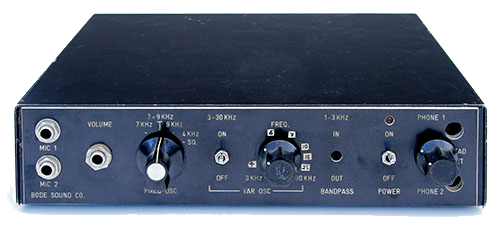
Bode Bird Song Pitch Shifter
For a number of years, I lugged this device around, using it rather sparingly, and always being annoyed by its size and by various drawbacks associated with using a heterodyne to lower the pitches (which often altered bird songs so much that it made them difficult to identify). As the digital age unfolded, I began longing for a smaller device that performed a more elegant pitch shift, just like my recorder did decades before, but functioning in real time.
So I hit the road in search of someone to help, and in the early 1990s I met Herb Susmann, an electrical engineer fresh out of Cornell University who took an interest in the project. Because birding was getting quite popular, and many older birders suffered from high frequency hearing loss, we decided there would be a market for a portable pitch-shifting device designed specifically for birders and other nature lovers. We immediately went to work designing a prototype, which we decided to call The SongFinder – A Digital Bird Song Hearing Device.
Luckily, a number of affordable, miniaturized digital signal processors (DSP chips) were appearing in the marketplace, with just enough “umph” to do the necessary work. A major challenge was developing an algorithm that would instruct the DSP to do the the pitch shifting. With a little hard work and some good luck, we soon conjured up a very effective solution.
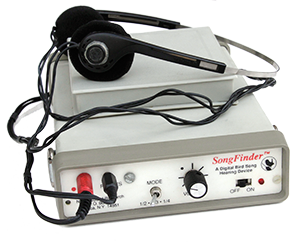
Our First SongFinder
The first SongFinder came into being in 1991. It was too large to fit in a pocket, but it was a major step up from the bulky Bode unit I had used before. Much attention went to the headset design, which involved carefully mounting miniature microphones so that they would be positioned at each ear. This allowed for binaural reception of sound and reasonably accurate judgement of the distance and direction of each birds song.
Our first customers were elated, some to the point of tears, at being able to hear the high-pitchers again. With the flick of a switch, they delighted once again in the high songs of waxwings, warblers, creepers, kinglets, and sparrows. Herb and I felt great about producing such a useful and life-changing product. Not only was my personal problem more-or-less solved, but other nature-lovers suffering from high-frequency hearing loss were now able to share in the fun, thanks to a one-of-a-kind device developed especially for people in their shoes.
In the early 2000s, we incorporated new electronic components that made the SongFinder smaller and more efficient. Our user base continued to grow, with the vast majority of buyers being hugely happy to have discovered the SongFinder solution. Around 2008, we improved the design once again, making the unit small enough to fit into a shirt pocket and extending the battery life to nearly twenty hours.
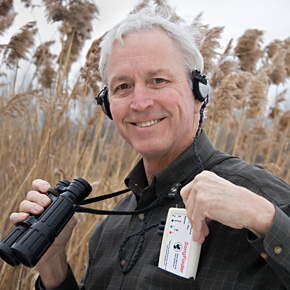
Lang with SongFinder in 2013
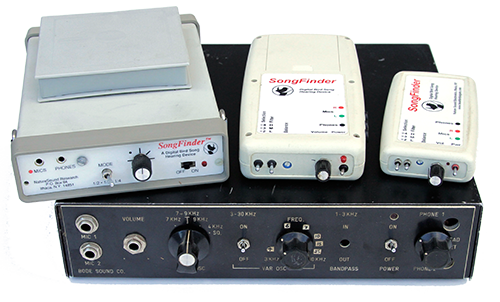
All Three SongFinder versions sitting atop my one-of-a-kind Bode Bird Song Frequency Shifter
Herb and I continued producing and selling the SongFinder until October of 2018, a 20+ year run during which we sold well over a thousand units. We decided to retire SongFinder production for a number of reasons, including its fairly high cost ($750), our extremely low profit margin, and our growing loss of interest in assembling units and building headsets. But perhaps the biggest factor had to do with all the advances made in mobile phone technology.
By 2018, it became clear to us that we needed a more flexible and modern solution and that the frequency shifting approach should be manifested as an application for mobile phones. Thus, as we brought SongFinder production to a close, I began looking more deeply at the possibility of creating an iOS app that would do the same thing, but do it better.
To make this happen, I needed to find a partner who is adept at programming and who is interested in birds. My first choice was Harold Mills, a good friend and an experienced programmer who helped develop sound analysis software for the Cornell Laboratory of Ornithology. He found the idea compelling and suggested we make it an open-source, non-profit project. I concurred and we soon agreed to work together to bring Hear Birds Again into being.
It took Harold and I nearly two years to pull things together, but here we are in December of 2022 and we are finally publishing the first version of Hear Birds Again … a cause for celebration! It’s been 44 years since Harold Bode built my first frequency shifter for bird song, and it’s high time I got this idea out of my system and into the world, on a much larger scale than before. At the ripe age of 74, I am ready to hand this idea over to others who will hopefully devise even better ways to bring bird songs back to those who suffer from high frequency hearing loss.

December 2022
